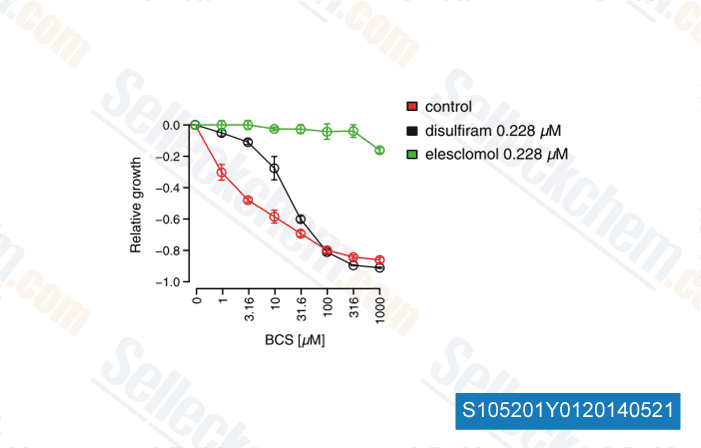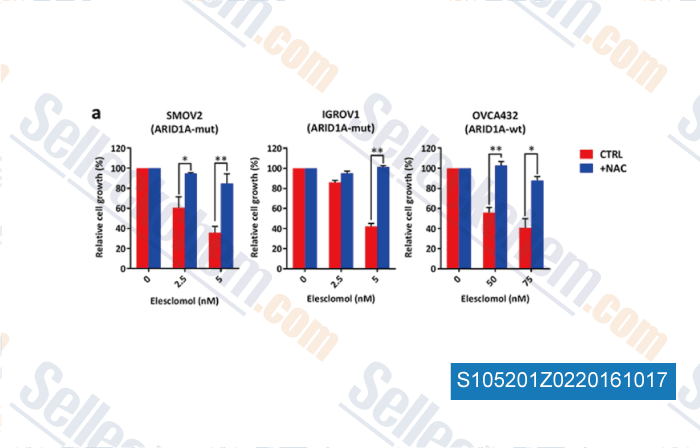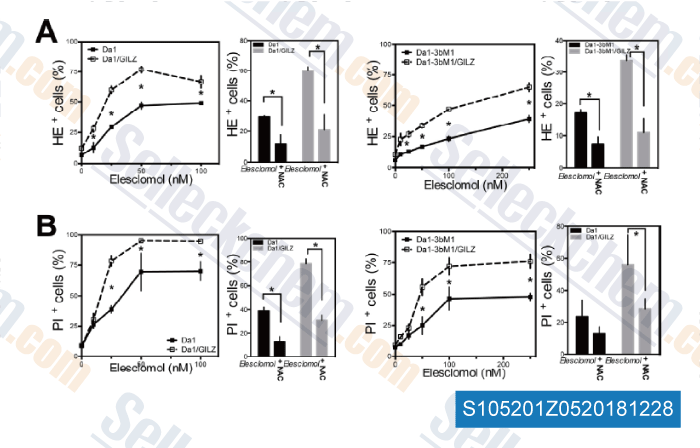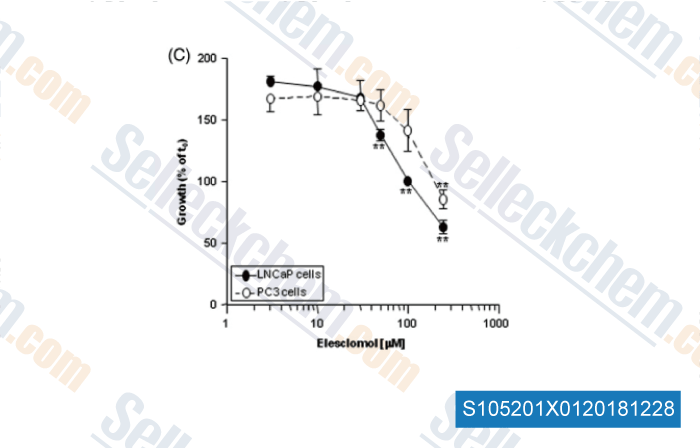|
Toll Free: (877) 796-6397 -- USA and Canada only -- |
Fax: +1-832-582-8590 Orders: +1-832-582-8158 |
Tech Support: +1-832-582-8158 Ext:3 Please provide your Order Number in the email. |
Technical Data
| Formula | C19H20N4O2S2 |
||||||||||
| Molecular Weight | 400.5 | CAS No. | 488832-69-5 | ||||||||
| Solubility (25°C)* | In vitro | DMSO | 80 mg/mL (199.75 mM) | ||||||||
| Water | Insoluble | ||||||||||
| Ethanol | Insoluble | ||||||||||
| In vivo (Add solvents to the product individually and in order) |
|
||||||||||
|
* <1 mg/ml means slightly soluble or insoluble. * Please note that Selleck tests the solubility of all compounds in-house, and the actual solubility may differ slightly from published values. This is normal and is due to slight batch-to-batch variations. * Room temperature shipping (Stability testing shows this product can be shipped without any cooling measures.) |
|||||||||||
Preparing Stock Solutions
Biological Activity
| Description | Elesclomol (STA-4783) is a novel potent oxidative stress inducer that elicits pro-apoptosis events among tumor cells. Phase 3.Elesclomol specifically binds ferredoxin 1 (FDX1) α2/α3 helices and β5 strand and inhibits FDX1-mediated Fe-S cluster biosynthesis.Elesclomol (STA-4783) is a potent copper ionophore and can be used in the research of copper-dependent cell death (cuproptosis). | |
|---|---|---|
| Targets |
|
|
| In vitro | Elesclomol significantly induces the expression of heat shock stress response genes and metallothionein genes, a signature transcription profile indicative of oxidative stress in Hs294T cells. Elesclomol (100 nM) rapidly induces Hsp70 RNA levels with a 4.8-fold increase at 1 hour and a 160-fold increase at 6 hours in Ramos Burkitt's lymphoma B cells in consistent with the intracellular ROS content which increases by 20% as early as 0.5 hour and 385% at 6 hours, and the induction of Hsp70 can be blocked by antioxidants NAC and Tiron pretreatment. Elesclomol increases the number of early and late apoptotic cells with 3.7- and 11-fold through the induction of oxidative stress, which can be completely blocked by NAC, while having little effect on normal cells. [1] Elesclomol significantly inhibits the cell viability of SK-MEL-5, MCF-7, and HL-60 with IC50 of 110 nM, 24 nM and 9 nM, respectively. [2] Elesclomol induces copper-dependent ROS generation and cytoxicity in yeast. Instead of working through a specific cellular protein target, Elesclomol interacts with the electron transport chain (ETC), a biologically coherent set of processes occurring in the mitochondrion, to generate high levels of ROS within the organelle and consequently cell death. [3] |
|
| In vivo | Although Elesclomol (25-100 mg/kg) as a single agent shows no antitumor activity in nude mouse xenograft models of human breast cancers (MDA435, MCF7 and ZR-75-1), lung cancer (RER) or lymphoma (U937), Elesclomol substantially enhances the efficacy of chemotherapeutic agents in these models, both in terms of tumor regression and extended survival of mice. [4] |
Protocol (from reference)
| Cell Assay: |
|
|---|---|
| Animal Study: |
|
References
Customer Product Validation

-
Data from [BMC Genomics, 2014, 15(1), 263]

-
, , Oncotarget, 2016, 7(35):56933-56943

-
Data from [Data independently produced by , , Int J Biochem Cell Biol, 2017, 85:166-174]

-
Data from [Data independently produced by , , Int J Radiat Biol, 2017, 93(2):194-203]
Selleck's Elesclomol (STA-4783) has been cited by 114 publications
| Mitochondrial-cytochrome c oxidase II promotes glutaminolysis to sustain tumor cell survival upon glucose deprivation [ Nat Commun, 2025, 16(1):212] | PubMed: 39747079 |
| Peripheral mitochondrial transplantation alleviates diabetes-associated cognitive dysfunction by suppressing cuproptosis [ Brain Res Bull, 2025, 222:111245] | PubMed: 39924054 |
| MUC20 regulated by extrachromosomal circular DNA attenuates proteasome inhibitor resistance of multiple myeloma by modulating cuproptosis [ J Exp Clin Cancer Res, 2024, 43(1):68] | PubMed: 38439082 |
| Protein phosphatase 1 regulatory subunit 15 A promotes translation initiation and induces G2M phase arrest during cuproptosis in cancers [ Cell Death Dis, 2024, 15(2):149] | PubMed: 38365764 |
| A combined AI and cell biology approach surfaces targets and mechanistically distinct Inflammasome inhibitors [ iScience, 2024, 27(12):111404] | PubMed: 39687021 |
| NFE2L2 and SLC25A39 drive cuproptosis resistance through GSH metabolism [ Sci Rep, 2024, 14(1):29579] | PubMed: 39609608 |
| Systematic identification of anticancer drug targets reveals a nucleus-to-mitochondria ROS-sensing pathway [ Cell, 2023, 186(11):2361-2379.e25] | PubMed: 37192619 |
| Circulating extracellular vesicles are monitoring biomarkers of anti-PD1 response and enhancer of tumor progression and immunosuppression in metastatic melanoma [ J Exp Clin Cancer Res, 2023, 42(1):251] | PubMed: 37759291 |
| Metabolic modulation of mitochondrial mass during CD4+ T cell activation [ Cell Chem Biol, 2023, 30(9):1064-1075.e8] | PubMed: 37716347 |
| Integrated single-cell and bulk characterization of cuproptosis key regulator PDHB and association with tumor microenvironment infiltration in clear cell renal cell carcinoma [ Front Immunol, 2023, 14:1132661] | PubMed: 37350959 |
RETURN POLICY
Selleck Chemical’s Unconditional Return Policy ensures a smooth online shopping experience for our customers. If you are in any way unsatisfied with your purchase, you may return any item(s) within 7 days of receiving it. In the event of product quality issues, either protocol related or product related problems, you may return any item(s) within 365 days from the original purchase date. Please follow the instructions below when returning products.
SHIPPING AND STORAGE
Selleck products are transported at room temperature. If you receive the product at room temperature, please rest assured, the Selleck Quality Inspection Department has conducted experiments to verify that the normal temperature placement of one month will not affect the biological activity of powder products. After collecting, please store the product according to the requirements described in the datasheet. Most Selleck products are stable under the recommended conditions.
NOT FOR HUMAN, VETERINARY DIAGNOSTIC OR THERAPEUTIC USE.
